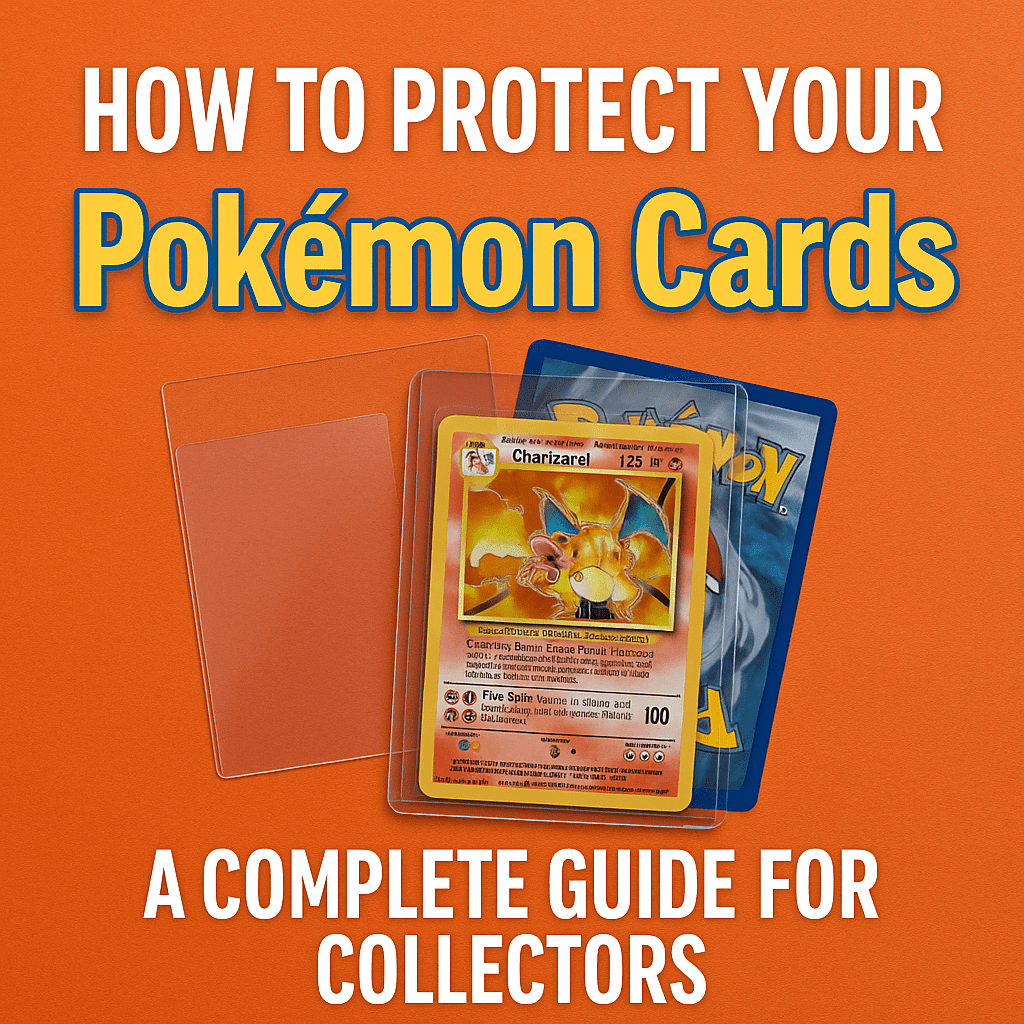Protecting your Pokémon cards from wear and damage is key to keeping them in great shape (and maintaining their value). A folded edge or creased corner can mean the difference between a card worth only pocket change and the same card selling for hundreds of dollars in mint condition. Collectors have a few main options for Pokémon card protection: sleeves, top loaders, and card savers. How do you know which to choose for your favorite Charizard or Pikachu? Let’s break down each option and when to use card sleeves, top loaders, or card savers to guard your treasured cards.

Card Sleeves
Card sleeves are the most basic and essential layer of protection for any trading card. A sleeve is a thin plastic pouch that slips over the card, covering it from both front and back. This shields the card’s surfaces from scratches, fingerprints, and dirt. In fact, the official Pokémon site notes that sleeving cards protects your cards from damage and even makes them easier to handle during a match. Every card you care about – even if it’s not super rare – should live in a sleeve to prevent minor wear. However, a sleeve alone won’t prevent bending or creasing, so for high-value cards you’ll often combine a sleeve with a sturdier holder.

Penny sleeves (also called soft sleeves) are ultra-thin, inexpensive clear sleeves often bought in bulk. They got their nickname because they cost only a penny or two apiece. Penny sleeves are perfect for everyday trading card storage and as an inner layer for other holders. They add virtually no thickness, so you can put sleeved cards into binder pages, top loaders, or semi-rigid holders without issue. Always use a penny sleeve before inserting a card into a top loader or card saver – this extra layer keeps dust off the card and prevents the hard plastic from scuffing the card’s edges. Just be gentle when sleeving and unsleeving cards to avoid catching a corner.

Deck sleeves are sturdier sleeves designed for cards in active play (like a deck you shuffle at tournaments). These sleeves are typically made of a slightly thicker plastic with an opaque back. They protect cards from handling wear and make shuffling easier during games. Tournament players are generally required to use identical opaque deck sleeves for their 60-card decks so no card backs are marked or visible. Deck sleeves come in many colors and prints, adding a touch of personal style to your play. If you plan to play with your cards (or carry them around), use quality deck sleeves and a deck box to keep your cards safe between matches. For very valuable cards that you play with, some players even double-sleeve (put the card in a thin inner sleeve, then into a deck sleeve) for extra protection. Just remember that sleeves protect surfaces, but they are flexible – they won’t stop a card from bending if it’s sat on or shoved in a pocket. For more rigid protection, you’ll need a holder like a top loader or card saver.

Top Loaders
Top loaders are rigid plastic card holders and one of the most common protectors in the hobby. A standard top loader is a 3×4 inch hard PVC sleeve that a card (inside its penny sleeve) slides into from the open top. The rigid plastic creates a tough barrier that prevents bending or creasing of the card. Once a card is in a top loader, its edges and corners are encased and much better protected from bumps or drops. Top loaders also have a bit of extra space inside, so the card won’t be overly tight – this makes insertion easier and avoids squeezing the card. Because the top is not sealed, however, dust or moisture can still potentially get in from the open end if you’re not careful. Collectors often put a small piece of painter’s tape over the top loader’s opening when shipping a card, to ensure the card can’t slide out during transit.
Top loaders shine for long-term storage, display, and shipping. Their stiff, rectangular shape makes them stackable and easy to organize in boxes or drawers. You can neatly file many top-loaded cards together without them tipping or bending, which is great for storage. The hard plastic is also more durable and rigid than a semi-rigid card saver, giving more peace of mind that your card won’t accidentally get bent. Because of this, collectors often choose top loaders for valuable cards they plan to hold onto or showcase. For example, if you pull a rare holo Charizard, you might sleeve it and put it in a top loader for trading card storage in your collection. Many sellers also ship cards in top loaders thanks to that solid protection. (It’s a good idea to sandwich the toploader between cardboard or use a padded mailer for extra security when mailing.)

On the downside, a top loader’s open top means it isn’t fully secure. If you drop a top-loaded card without tape on the top, the card could slip out. Also, the small amount of wiggle room inside can sometimes let the card shift or slide. Always use a penny sleeve inside to add friction so the card doesn’t move much. Another consideration: when it comes to professional grading, some grading services don’t love top loaders. PSA (a major grading company) has warned against submitting cards in top loaders, preferring card savers for card submissions. (If you send cards to PSA in top loaders, they’ll still grade them, but they may remove the card and not return your top loader.) For pure protection of ungraded cards in a collection, though, top loaders are a time-tested choice. At only around 10–15 cents each, they’re also quite affordable, so you can stock up on them for your valuable pulls.
Card Savers (Semi-Rigid Holders)
Card savers are another popular protector, often used for mailing cards or preparing cards for grading. A card saver is a semi-rigid holder made of flexible plastic (often polyethylene or Mylar) that holds the card more snugly than a top loader. These holders are taller and a bit thinner than top loaders, and they feature a little half-inch lip at the top. You insert the card through the opening at the top, and the lip gives you a grip or “runway” to guide the card in without dinging the corners. The fit is tight enough that the card doesn’t shuffle around at all inside – it stays firmly in place. Like with top loaders, you’ll want to put the card in a penny sleeve first for easier insertion and surface protection.

Card savers excel when you need a secure, slim holder. Because the plastic is semi-rigid, it’s somewhat flexible rather than completely hard. This means if you drop a card saver, the card is less likely to jolt out (since it’s basically wedged in place). Many collectors use card savers to send cards through the mail or to submit cards for grading. In fact, grading authorities like PSA specifically prefer cards be sent in card savers – PSA even used to require Card Saver I holders for all submissions and cautioned that cards in top loaders could experience processing delays. The snug fit also makes it easier for graders to remove the card safely. For similar reasons, if you’re selling or trading a high-value raw card, you might choose a card saver so the card stays centered and won’t slip out during transit. Card savers are also quite thin, so you can fit a large number of them into a storage box compared to the same number of top loaders. This can be handy if you have many cards you’re organizing or sending off.
There are a few drawbacks to keep in mind. First, card savers are only “semi-rigid” – the holder will bend if enough pressure is applied. They do protect against typical knocks and keep a card from bending in normal handling, but they’re not as stiff as a top loader. Over a very long time, the plastic can even warp slightly, which might cause a card inside to develop a slight curve. (If you store card savers flat under heavy weight or in fluctuating heat, check them occasionally to make sure no warping is occurring.) Also, that extra lip on top, while useful, makes card savers taller – they may not fit in some standard cardboard card boxes or tins that perfectly fit top loaders. The lips can sometimes get bent or tear off if you handle them roughly. Aesthetically, some collectors simply prefer the look of a rigid top loader for display since card savers are a bit more flimsy and flexible in hand. Despite these minor downsides, card savers are inexpensive (roughly the same cost as top loaders) and are an industry standard for submissions. It’s wise to keep a pack of Card Saver I-style holders around if you plan on mailing cards out. Just remember to always use a sleeve inside, and consider putting the card saver in a resealable bag (“team bag”) if you want to fully seal it against dust during long-term storage.

Storing and Handling Your Collection
Trading card storage isn’t just about the individual sleeve or holder – where and how you keep your cards will impact their condition over time. Whether you use sleeves, top loaders, or card savers, also keep these TCG storage tips in mind to protect your collection:
-
Store in a cool, dry place: Cards last longest in a stable environment. Keep them away from high humidity, extreme heat, and direct sunlight to prevent warping or fading. For example, avoid leaving your collection in a damp basement or in sunlight on a shelf.
-
Use proper storage containers: Consider dedicated card storage boxes or bins to organize your cards (many are designed to fit standard top-loaded cards or sleeved cards). If using a binder, use archival-quality pages and insert cards (in sleeves) into side-loading pocket pages so they won’t slip out as easily. A good deck box will protect sleeved cards you carry to events.
-
Handle with clean hands: Oils or residue from your hands can accumulate on cards. Before sleeving or placing a card in a holder, make sure your hands are clean and dry. Avoid eating snacks or having drinks near unprotected cards to reduce the chance of spills or stains.
-
Check on your cards periodically: If cards are stored long-term, it’s a good idea to inspect them once in a while. This lets you catch any issues like a card beginning to curl, or sleeves that have split. It also ensures that no dust or moisture has sneaked in. Re-sleeve cards if a sleeve becomes torn or dirty.

By choosing the right protection for the right situation – and practicing smart storage habits – you’ll keep your Pokémon cards safe and looking gem mint for years to come. Happy collecting!







![[ Complete Guide ] What’s the Best Binder for Pokémon Cards?](http://ravaver.com/cdn/shop/articles/ChatGPT_Image_2025_8_1_11_24_22-3392767.png?v=1757311484&width=1536)


